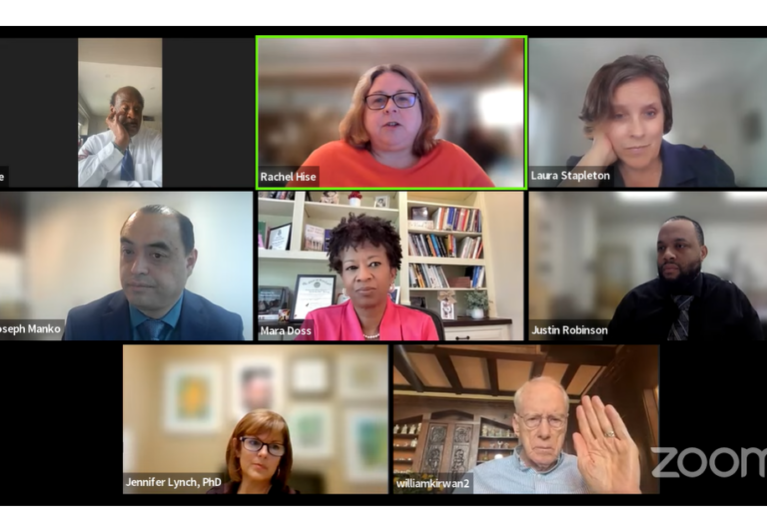According to the College Board, annual tuition and fees nationally for a four-year public university from 2017 to 2018 averaged $9,970. The Maryland Higher Education Commission reported that average tuition and fees in 2018 for Maryland public universities is $9,260.
The cost of colleges has been a major public policy issue in both Democratic and Republican administrations in Maryland. The O’Malley administration began the latest cycle of tuition freezes while the Hogan administration provided funds to limit tuition increases to no more than 2 percent. From fiscal 2009 to 2019, state funds for higher education in the University System of Maryland grew 29.1 percent while tuition and fees revenue grew 29.5 percent. Maryland’s spending did not really outpace tuition increases compared to the rest of the nation.
While both the Democrats and Republicans have offered their own proposals for addressing the cost of higher education, I believe neither party has a correct understanding of the nature of college costs. Neither party appears to want to confront the root of the problem and investigate how colleges are spending their money. Instead, we seem to avoid the issue and pass legislation whose premise is based more on an appeal to desperation than anything else.
Gov. Larry Hogan and Democratic gubernatorial candidate Benjamin Jealous advocated free community college, a respectable idea on paper that has good intentions. House Bill 16: Community Colleges-Near Completers and Maryland Community College Promise Scholarships was signed into law by Gov. Hogan in May 2018 to establish such a program in Maryland community colleges starting in 2019.
The fiscal reality is that free community college would raise taxes somewhere down the line for Marylanders. In contrast, the latest Goucher poll from September 2018 suggested that 56 percent of Marylanders — regardless of political party or ideology — believed that they pay too much in taxes already. Would Marylanders be willing to pay for free community college?
The only other alternative I see is to cut spending, which is something I believe Maryland colleges can do much better.
Although Maryland has made some progress in controlling tuition increases, I cannot help but wonder still if there is something more we can do. The Goucher poll from spring 2016 claimed that 73 percent of Marylanders rated Maryland “as a ‘good’ or ‘excellent’ place to get a quality college education.” Yet the cost of college deters some people from enrolling in the first place.

Michael Raup
Researchers disagree on the main cause for increasing higher education costs today. In the 1980s, Secretary of Education William Bennett issued the Bennett hypothesis arguing that financial aid causes colleges to increase tuition, an idea still debated today. Others believe that decreases in state funding force colleges to raise tuition to compensate for losses.
An analysis from the Bipartisan Policy Center showed nationwide tuition still increased nearly 50 percent for public institutions from 2000 to 2015. However, revenues from tuition only increased 17 percent in that same time period. Some economists such as Richard Vedder put the blame on the market forces of supply and demand.
Furthermore, other cost drivers studied in the literature, include but are not limited to, are building maintenance, federal and state regulation compliance, and faculty recruitment. Whatever the cause, it is a complex subject of study and no one factor can be blamed.
I think that our material culture and secular attitude are large contributors to the problem, also. We want what we cannot have and must continue to spend money to satisfy our ourselves — students and administrators alike. Perhaps the best approach lies in the old adage, “follow the money.”
As a staffer in the Maryland General Assembly last session for a senior member of the Appropriations Committee, I often watched college presidents from public and private colleges come to my office to ask my legislator for more funding. This also was reflected in the letters I read from college presidents from both sectors. It seemed funding was never enough because there were always “unmet needs,” a loaded term in itself subject to interpretation.
My research and personal experiences in college have made me believe major drivers behind increasing costs are the programs offered at colleges and their supporting byzantine bureaucracies. In 2014, the Delta Cost Project at the American Institutes for Research, arguably the nation’s leading authority on college financing, published a study revealing that the number of higher education employees nationwide increased by 28 percent from 2000 to 2012 — 50 percent faster than the previous decade. A major component of costs included faculty compensation, according to the study, although this is not the only cause (a follow on study in 2016 goes into more nuances).
The Delta Cost Project further classifies states by how their colleges spend revenues. The most recent dataset showed Maryland saw a 10 percent increase on education and related spending from 2005 to 2010, compared to the national average of 8 percent for bachelor’s degrees at public universities.
What I found interesting in my examination of the Delta Cost Project is how much revenue is unaccounted for in the study of Maryland. Is only 50 percent of spending really going just to education and related costs? While each study has its limitations in data collection, it begs the question as to where the money is truly going. As an undergraduate student, I remember questioning why my college had so many programs and services that I paid for that I never used. They still appeared on my bill, nevertheless, without my permission, grouped underneath a label called “fees.”
When I examined the expenditures for Maryland public universities from the Maryland Higher Education Commission’s 2018 Data Book, I found that only 38.3 percent of expenditures were spent on actual instruction. Research had 7.0 percent; public service, 1.9 percent; academic support, 13.2 percent; student services, 6.4 percent; institutional support, 14.0 percent; operations and maintenance, 12.9 percent; scholarships and fellowships, 6.2 percent; other, 9.3 percent. I found these numbers were vague. What distinguishes student services from institutional support? Moreover, what is considered “other?” I did not find much clarification either when looking through the annual 2017 financial statements of the University System of Maryland available online for public viewing.
Concerns such as these were found even back in 2006 with Secretary of Education Margaret Spellings and her Commission on the Future of Higher Education. The commission reported how “college and university finances are complex, and are made so by accounting habits that confuse costs with revenues and obscure production costs . . .[which] . . . reflects a deeper problem: inadequate attention to cost measurement and cost management within institutions.”
It is hard to say whether Maryland is doing enough to manage the cost of higher education today. I would hope that Maryland’s numbers are being accurately reported.
But perhaps we can go a little further and investigate how Maryland colleges spend their money and find ways to hold them accountable in the first place. If such an investigation were done, I believe we would find much waste, fraud and abuse which students ultimately must pay for in the long run. Many programs likely are unneeded and could be eliminated or outsourced, an idea I share with another expert.
Marty Nemko, a nationally recognized expert in higher education policy, proposed subsidizing off-campus housing and outsourcing other campus services to the community as a good way to reduce college costs. For example, health care, counseling and other recreation could be provided to students directly through the community instead of on campus. If such outsourcing occurred, it might allow administrators to cut down on their programs, staff and compensation because students receive their services directly from the community instead. Other countries have used this model to some degree of success that warrant further study.
We might be able to learn some lessons from our European counterparts. While Europe has a different market structure than the U.S., some findings can be still be drawn. Many European universities do not offer the same amenities as American colleges do, such as campus housing. These European universities are structured so that many facilities are offered in the city, not on college campuses. Compared to some other nations in the Organisation for Economic Co-operation and Development, the U.S. spends much more on higher education than other nations. Undoubtedly, these same nations have managed their costs much more efficiently than we have done. What is essential to the mission of education? Is the purpose of college to entertain or educate? The answers to these questions would highlight the differences in culture and attitude between the United States and Europe.
Our consumers, government and colleges all hold part of the blame for this problem. With insatiable demand for services, consumers have asked colleges to provide the extra amenities seen on campuses which began with the Ivy League universities in the 1960s. Government budgets can only cover so much funding for colleges next to other competing demands, and colleges must continually expand their programs to compete not only with each other but prepare students for a globally competitive workforce. In the end, students must pay for the cost of college either way, whether justifiable or not.
The discussion of how to manage college costs will continue unless the Maryland General Assembly decides to have the political will to hold colleges accountable for their spending practices. Annapolis is certainly not Washington — we can and should do better to manage our college costs and make them affordable for all students without passing artificial legislation.
— MICHAEL RAUP
The writer is a graduate of the University of Maryland, Baltimore County with an undergraduate degree in political science. During his time at UMBC, he served as a student consultant to the Commission on Innovation and Excellence in Education. He is a former staffer of the Maryland General Assembly with interests in the politics of higher education and economic inequality.




 Creative Commons Attribution
Creative Commons Attribution